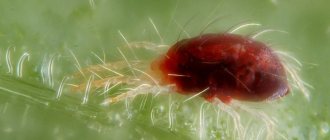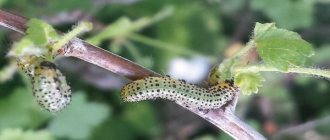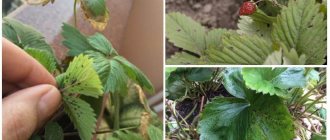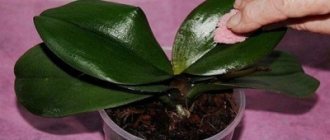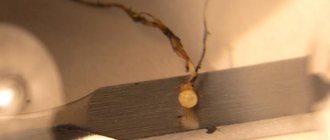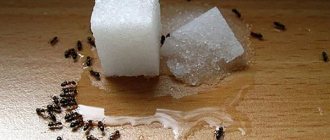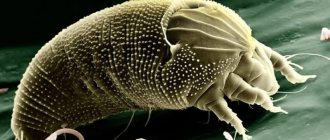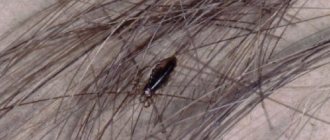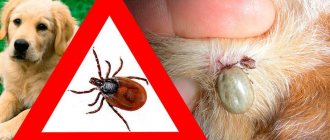Caring for and planting plants is sometimes very problematic. In particular, various harmful insects do not give rest. Strawberry mite is a common occurrence, especially when conditions are good for this pest. Due to the fact that it is dangerous for escapes. The mite infects all parts, causing the death of bushes and poor harvest. This pest needs to be fought.
Dear readers! For you, we have created communities on social networks in which useful articles and interesting ideas are published several times a day! Subscribe and receive useful content in a convenient format!
Description
Ticks (Phytonemus pallidus) are dangerous and small parasites, visible only through a magnifying glass, which makes them difficult to control. If there is a global defeat, there is a possibility of being left without a harvest both in the current and next season. This is motivated by the fact that mites damage flower buds throughout the season. Often the tick attacks individuals older than 3 years.
Types of ticks
Strawberry mite is a general name for a number of pest species.
There are 3 types of these harmful creatures.
Transparent tick (Polyphagotarsonemus latus) - found in moist soil, it becomes active around mid-March, when the temperature on the thermometer reaches +13°C. Spreading over the strawberry bushes, it takes all the juices from the leaves.
Common spiderweb (Tetranychus urticae) - this parasite prefers warm, dry leaves. It also becomes active in March-April. Active reproduction occurs at t =+12°C. The specificity of tick entomology is the formation of a web (hence its name).
Cyclamen mites (Phytonemus pallidus). This type of parasite is similar to the two described above, with the exception of a number of differences: the dimensions of the insect are much smaller. The female's back has no spots. They do not secrete cobwebs. The movement occurs passively - on leaves that have been torn off by the wind. Also, mite infestation occurs through transfer on clothing.
The food for the cyclamen and common spider parasites are substances from strawberry leaves and other crops.
Causes of defeat
Garden pests prefer warm, humid weather, when the thermometer rises to +19 - +25 degrees with a humidity of 80-90%. In such conditions, strawberry mites quickly develop and reproduce.
Maximum insect activity occurs at the end of July and beginning of August, when the soil becomes less wet.
How do strawberry mites appear on strawberries?
- The gardener purchases already infected planting material.
- Pests are carried on gardening tools.
- Ticks get onto strawberry plantings from clothes and shoes.
With the onset of cold weather, the males of these arthropods die, and the females prepare for winter by completely refusing food. They hide behind stipules at the base of bushes or inside unopened young leaves.
How to deal with strawberry mite?
You can fight ticks in various ways:
- using chemicals;
- using folk remedies;
- by growing plants that control harmful insects;
Drug treatment methods
An effective measure in the fight against garden parasites, in which there is a probability of getting rid of 90-95% of its numbers, is to mow the grass immediately after harvesting.
This procedure should not be put off for a long time, since the shoots need time to grow their crown before the onset of cold weather. After this, you need to spray the bushes with one of the preparations listed below.
Next, you need to spray the cleaned area 3 times, with an interval of 7 days, with biological pesticides “Fitoverm” or “Akarin”. Proportions – 20 ml/ bucket of water.
Also effective are “Fufanon” (30 ml / 10 liters of water), “Aktellik” (15 ml per 10 liters of water). Chemicals must be applied during breaks - the tick quickly adapts to the drugs.
How to get rid of it using folk remedies?
There are many folk remedies for pest control, let's look at some of them.
How to treat with onion peel tincture
In the spring, with the appearance of 1 leaf, at the stage of bud formation and 2 times after picking the berries, it is possible to defeat the mite with a tincture of onion peels.
The recipe for the product is as follows: 200 gr. dry substance should be poured with a bucket of water, left for 4-5 days, strain. Next, spray the strawberry bushes with infusion.
Decoction of tomato leaves
A decoction of tomato leaves works well against bream.
Preparation:
- 1 kg. Tomato tops are poured with 10 liters of water and left for several hours.
- Next, the infusion is boiled for three hours, filtered, diluted with water in a proportion of ½, and 40 grams are added. household soap
- After cooling, strawberry beds are processed with this mass.
Garlic broth
Garlic broth also works well - 0.5 liters per bush. To achieve the result, it is advisable to cover the treated seedlings with polyethylene film for 5-6 hours.
Attention! Spraying with poisons, such as Karbofos, is recommended only after picking the berries. During this procedure, you need to thoroughly wet the young leaves, since the mite mainly settles on them.
other methods
It is good to fight ticks by warming the ground. Why, after harvesting, you need to mow down all the leaves, after a few days the garden needs to be treated with fire, then water the strawberries heavily. Further care consists of manipulations such as fertilizing, weeding, and shelter for the winter.
Plants that repel ticks
Plants that help fight ticks.
Tansy
This plant is the most effective protector against ticks.
For many of us, this is just a roadside weed, but it has found its place in gardening and dacha affairs.
Perfect as an alternative to pesticides, fighting against fungus on the plant.
The use of tansy on the site is primarily a fight against ticks. The effect of tansy lies in its smell, which resembles camphor. This plant also repels other pests with its “aroma”. Tansy grows best in areas with clay soil.
Cat mint
Another “tick repeller” is Catnip (Catnip).
This plant is low, about 40 cm, with slightly spreading stems.
Catnip decorates the garden from mid-summer until September.
The strong smell repels ticks.
The flowers contain an essential substance – in particular nepetalactone. Ticks don't like it. In addition, this cat plant is unpretentious when growing.
Lavender
Only not mountainous, but narrow-leaved.
The specific smell repels ticks. Contains essential oil, the key components are ocimene, linalool, camphor.
They are not tolerated by ticks and mosquitoes.
Rosemary officinalis
This medicinal plant repels ticks well and has healing properties.
Pests cannot tolerate the aroma of this plant.
It is better to plant it in soil with a neutral pH, in a well-lit and heated place. It cannot winter on the site, as it does not tolerate low temperatures well.
Dalmatian chamomile
Another name is Pyrethrum.
It contains toxic substances peritrin and cynerin, which damage the muscles and nervous system of insects. Dalmatian chamomile blooms all summer, forming light yellow baskets. The plant feels comfortable in fertile soil and a sunny place.
Strawberry varieties resistant to mite
Wild berries with small fruits are usually resistant to the parasite, but can be its carrier.
The garden variety “Omskaya Rannyaya” is partially resistant to mites. Virtually unaffected by:
- "Torpedo";
- "Dawn";
- "Knight".
Varieties with a high percentage of glucose in the berries are not resistant to the pest.
In the fight against ticks, preventive measures are important:
- The seedlings do not tolerate unsanitary conditions and love ventilation and lighting.
- There is no need to plant strawberries in the shade or in areas where water stagnates.
- It is recommended to loosen the soil more often, hill up the bushes, and feed the bushes on time. Thus, optimal conditions are provided for the development and growth of plants, increasing resistance to pests, which include the mite that attacks strawberries.
Attention! Do not forget about crop rotation - a plant can be grown in its original place no earlier than after four years.
What is recommended before planting?
- Loosen the soil more often, hill up the bushes, and feed them in a timely manner.
- When using your seedlings, young bushes are completely immersed in hot water for 15 minutes, then rinsed in cold water and planted in the ground. This procedure must be carried out no later than August 15: before winter, the seedlings must take good roots and develop a developed bud.
- In the early stages of detecting the parasite, it is necessary to remove both the affected bushes and the neighboring ones.
You should not rely 100% on any one processing method. Sometimes high-quality chemicals drugs will not be able to defeat the pest completely and forever. All “medicines” have restrictions that must be strictly followed.
Do not think that spring treatment can rid you of ticks for the entire season. The effect of the drugs only restrains the population, but does not completely destroy it.
Perhaps the main mistake on the part of gardeners and summer residents is untimely care of the site. That is, we need to regularly pull out weeds, monitor the appearance of seedlings “eaten up” by the pest, and clean the beds.
More information about ticks
The strawberry mite looks like all representatives of this family - the small pest has a flat, translucent oval-shaped body, with triangular legs, length is 0.15-0.2 mm, width 0.08-0.1 mm. The color is pale green, yellowish or yellowish-brownish. An adult is shown in the photo above.
Their habitat is represented by areas with a temperate climate, so they are widespread in our country. Individuals overwinter at the base of bushes, in the folds of young, not yet unfolded leaves, in cracks in the surface of the main stem. In the spring, when the air outside warms up enough, females lay eggs in young, not yet unfurled leaves.
Development from the initial stage to an adult individual occurs in 30-40 days, depending on the outside temperature and humidity.
Optimal conditions for the development of the parasite are determined by air temperature from +15 0C to +25 0C and relative humidity of 80 percent. Under favorable breeding conditions, up to 7 generations can appear on your site in one season.
What types of ticks are there?
In our garden plots, the two most common types of these parasites are:
- Strawberry transparent;
- Cyclamen.
The cyclamen type (lat. Tarsonemus pallidus), in turn, is distinguished by a more elongated body and legs.
Unfortunately, it is quite problematic to see the differences between the species of these insects, because the sizes of individuals are microscopically small.
In addition to the two species described above, the following representatives of this family are often found on personal plots:
- Arachnoid;
- Greenhouse transparent;
- Wheat flower;
- Oatmeal extended;
- Narcissus.
Harm
The strawberry mite stops the growth of buds on the plant throughout the growing season. The tick is especially dangerous for adult bushes. Colonies of parasites settle on the underside of the foliage of succulent young greenery. The plant juices are drawn out, thereby depriving the bush of strength for further growth and fruiting. Pests can attack both mature bushes and new rosettes on the tendrils.
You can tell that strawberries have suffered from a mite infestation by the following signs:
- the growth of the bushes slows down greatly, then stops, the bushes become dwarf;
- young leaves began to appear in “waves” and became wrinkled and twisted;
- the leaves acquire a yellowish-oily tint and dry out at the height of the season;
- young leaves cannot open, their edges are fastened;
- on the back side of the leaf plates you can see a silvery coating;
- the fruits dry out before they have time to ripen;
- the bushes cannot tolerate winter temperatures and die.
These alarming signs on berry plantings cannot be ignored. Successfully fighting strawberry mites is not easy, but it is possible.
During processing, special attention should be paid to the center of the bush - mites primarily attack young leaves.
Signs of strawberry damage
As we have already said, it is almost impossible to see the small pest with the naked eye, therefore, to determine whether our plantings are actually affected by this pest, it is necessary to conduct a visual inspection.
We need to inspect every bush, otherwise we risk missing the source of the parasite colony.
Adults feed mainly on young tender ones, piercing the skin (epidermis) of plants and sucking out cell sap, which leads to a slowdown in the development of the plant until its death. The main signs of the presence of insects on strawberries are:
- Shriveled and yellowed leaves;
- The berries and the underside of the leaves are covered with a silvery-white coating;
- Dried leaves, flowers, berries;
Infected plants lose frost resistance, stop developing and die.
Reasons for appearance
There are climatic and agrotechnical conditions favorable for the appearance of the strawberry mite on strawberries, its rapid development and reproduction. The first group includes:
- heat: temperature - 19-25°C;
- high humidity: 80-90%.
Peak activity occurs at the end of July and beginning of August. Agrotechnical conditions favorable for its appearance include:
- acquisition of infected planting material;
- use of garden tools not treated with disinfectants;
- unkempt strawberry beds overgrown with weeds;
- dense plantings;
- old planting site - if strawberries have been planted in the same bed for more than 4 years.
If a person cannot change the climatic conditions favorable for the reproduction and spread of strawberry mites, then the basic rules for growing strawberries should be followed. According to experts and as practice shows, this will get rid of the pest invasion.
Chemicals
To treat plantings with chemicals, it is better to choose the time when the harvest has already been harvested. You should not postpone the procedure, otherwise the mites will destroy the plantings. Thanks to timely treatment, it is possible to get rid of 95% of pests.
To eliminate mites, spraying three times at weekly intervals is required. It is recommended to change the drugs each time so that the insects do not develop an addiction. The most effective anti-tick chemicals are:
- Fitoverm, Akarin. Insecticides of contact-intestinal action based on aversectin. For treatment, 20 ml of the product is diluted in a bucket of water.
- Fufanon, Karbofos. The main component is malathion. It disrupts the transmission of nerve impulses in insects. You will need 30 ml of the drug per 10 liters of water.
- Actellik. Non-systemic insecticide of contact-intestinal action with pirimiphos-methyl. Dilute 15 ml in a bucket of water.
- Neoron. Based on bromopropylate. The substance has a damaging effect on adults and partially on eggs. Dilute the product at the rate of 5-6 ml per 5 liters of water.
- ThiovitJet. The drug stops the growth of insects. It will take 30-80 ml per bucket of water, depending on the concentration of the solution.
Related article:
Rhythmic techniques for flower beds and mixborders
Spraying of plants is carried out wearing protective clothing, a mask, and gloves in the morning or evening in calm weather. For irrigation you will need a garden fine sprayer. Since mites are located in rosettes and on the underside of leaves, it is important to treat the entire surface of the bush.
